
Topics
Guests
- Jonathan Schellleading advocate for nuclear disarmament and the Doris Shaffer Fellow at the Nation Institute. His most recent book is The Seventh Decade: The New Shape of Nuclear Danger. His latest article in The Nation is “Reaching Zero.”
President Obama and Russian President Dmitry Medvedev have signed a landmark nuclear arms reduction treaty to replace the expired Strategic Arms Reduction Treaty of 1991. While Obama has said the treaty will cut the US and Russia nuclear arsenals by a third, arms-control experts have warned the figure is misleading because the new pact uses different counting rules than previous agreements. We speak to veteran journalist and leading nuclear disarmament advocate Jonathan Schell. [includes rush transcript]
Transcript
JUAN GONZALEZ: President Barack Obama and Russian President Dmitry Medvedev have signed a landmark nuclear arms reduction treaty in Prague. The treaty calls for the United States and Russia to cut their deployed arsenals to 1,550 nuclear warheads and 700 missile silos and bombers each. Obama has called the new Strategic Arms Reduction Treaty “the most comprehensive arms control agreement in nearly two decades.”
PRESIDENT BARACK OBAMA: Today is an important milestone for nuclear security and nonproliferation and for US-Russia relations. It fulfills our common objective to negotiate a new Strategic Arms Reduction Treaty. It includes significant reductions in the nuclear weapons that we will deploy. It cuts our delivery vehicles by roughly half. It includes a comprehensive verification regime, which allows us to further build trust. It enables both sides the flexibility to protect our security, as well as America’s unwavering commitment to the security of our European allies. And I look forward to working with the United States Senate to achieve ratification for this important treaty later this year.
Finally, this day demonstrates the determination of the United States and Russia, the two nations that hold over 90 percent of the world’s nuclear weapons, to pursue responsible global leadership. Together, we are keeping our commitments under the Nuclear Non-Proliferation Treaty, which must be the foundation for global nonproliferation. While the new START treaty is an important first step forward, it is just one step on a longer journey. As I said last year in Prague, this treaty will set the stage for further cuts, and going forward, we hope to pursue discussions with Russia on reducing both our strategic and tactical weapons, including non-deployed weapons. President Medvedev and I have also agreed to expand our discussions on missile defense. This will include regular exchanges of information about our threat assessments, as well as the completion of a joint assessment of emerging ballistic missiles.
JUAN GONZALEZ: While President Obama said the treaty will cut the US and Russia nuclear arsenals by a third, arms-control experts warned that the figure is misleading because the new pact uses different counting rules than previous agreements. Hans Kristensen of the Federation of American Scientists said the new deal would represent an actual decline of only about 100 or 200 nuclear weapons — a reduction of only as much as 13 percent.
AMY GOODMAN: We’re joined now by veteran journalist Jonathan Schell, leading advocate for nuclear disarmament and the Harold Willens Peace Fellow at the Nation Institute. His most recent book is The Seventh Decade: The New Shape of Nuclear Danger. His latest article in The Nation is “Reaching Zero.” He is joining us from Yale University.
Jonathan Schell, welcome to Democracy Now! How significant is this signing today between the Russian president and President Obama?
JONATHAN SCHELL: First, let me begin by saying that I’m actually the Doris Shaffer Fellow at the Nation Institute, just to make that clear.
But it’s a very modest agreement. It’s good. It’s good that there will be cuts. There are other things that are positive in it. In the new Nuclear Posture Review, the administration has decided to forgo further testing. They’ve promised further rounds of cuts. All this is positive. But they’re very, very modest achievements.
And if — I was watching the clip with Obama and Medvedev just now, and a question formed in my mind, and that is, why are these two gentlemen, who are sort of whispering in a friendly way to one another and talking about their good personal relationship and chemistry and so on, why is it that after signing an arms control agreement they are still aiming 1,550 nuclear weapons at one another? You know, it’s enough still to blow up both of the countries many times over.
And what this treaty leaves intact is the entire Cold War nuclear apparatus. You know, the number of weapons at the height of the Cold War was so high that it was really quite possible to cut them and cut them and cut them over the years since then without ever touching the sort of core of the matter, which is the ability of each country to blow up the other many times over, as I say. And so, all of that is left sort of sailing on into the post-Cold War era, and it hasn’t yet been touched or affected in any way. And so it’s a very sharp limitation on the meaning of this agreement.
JUAN GONZALEZ: And Jonathan Schell, as you’ve noted in your article in The Nation, of the 23,000 estimated nuclear warheads in the world, 95 percent of them are held by these two countries, the United States and Russia. So, really, their ability or their willingness to reduce their arsenals is really at the core of what will happen in terms of nuclear disarmament in the world, isn’t it?
JONATHAN SCHELL: Well, yes. You know, maybe this will reduce it. Obama used the figure 90 percent, 90, 95 percent represented by the two countries’ arsenals. And maybe this will bring it down to 85 percent or 80 percent, depending on how you count the cuts and so forth.
But another aspect of this that’s very key is that right now, as the Nuclear Non-Proliferation Treaty review conference gets going in May, a kind of basic question has been placed before the world, and that is whether nuclear weapons are important for the security of nations or not. The United States has really given two answers to that, that contradict, because when they approach other countries in the world, the answer is, no, they are not useful, you must not have them, and, in fact, according to new Nuclear Posture Review, the policy of the United States now is something that’s rather surprising, and that is that if you don’t obey the rules of the NPT and if you do go down the road towards nuclear weapons, we may attack you actually with nuclear weapons. This is the new policy, which is quite striking. So that’s one answer. But when it comes to the United States and its allies and Russia and so forth, the answer is quite different, and it turns out that we’re going to need 1,550 of these things, and with no plan in the foreseeable future to go down to a level that would really be below the overkill levels that I was talking about before. Now, those two things don’t mix well.
The Posture Review has now done something that’s new in American policy, and that is it’s placed the nonproliferation objective as number one in the policy list, and the defense of allies and all of that is only number two. But actually, the number two and the position taken there, holding onto so many weapons, badly undercuts the primary objective. And so, there’s a kind of a walking contradiction here that hasn’t been resolved, certainly not by this treaty or by the Nuclear Posture Review that just came out the other day.
JUAN GONZALEZ: Well, and the signing of that US-Russian nuclear arms treaty comes, as you mentioned, days after the Obama administration released a new national strategy for nuclear weapons. Under the new Nuclear Posture Review, the US for the first time is pledging not to use nuclear weapons against non-nuclear states that are in compliance with the Nuclear Non-Proliferation Treaty. But the policy leaves open the possibility of a US nuclear strike against Iran and North Korea and other nations accused of violating the treaty. President Obama addressed the new policy earlier today in Prague.
PRESIDENT BARACK OBAMA: Earlier this week, the United States formally changed our policy to make it clear that those nuclear-weapons states that are in compliance with the Nuclear Non-Proliferation Treaty and their nonproliferation obligations will not be threatened by America’s nuclear arsenal. This demonstrates, once more, America’s commitment to the NPT as a cornerstone of our security strategy. Those nations that follow the rules will find greater security and opportunity. Those nations that refuse to meet their obligations will be isolated and denied the opportunity that comes with international recognition. That includes accountability for those that break the rules. Otherwise, the NPT is just words on a page.
That’s why the United States and Russia are part of a coalition of nations insisting that the Islamic Republic of Iran face consequences, because they have continued — continually failed to meet their obligations. We are working together at the United Nations Security Council to pass strong sanctions on Iran. And we will not tolerate actions that flout the NPT, risk an arms race in a vital region, and threaten the credibility of the international community and our collective security.
AMY GOODMAN: That’s President Obama in Prague just right before the broadcast.
Jonathan Schell, is this is all about — is the significance of this right now, meeting with the Russian president, about Iran and trying to push Iran to support sanctions against — trying to push Russia to support sanctions against Iran?
JONATHAN SCHELL: Yes, it’s very much about Iran, and it’s also about North Korea, where, of course, there are similar efforts — in that case, to try to get them to roll back their nuclear program, because nuclear — North Korea is, of course, already a nuclear power, having tested two weapons.
I think it’s a little bit complicated, but I think it’s very important to zero in on this exception to the no-first-use policy. And let me try to go through it just for a moment, if I may. Before the treaty was signed and the Nuclear Posture Review was released, there was a lot of talk in the media about whether the United States would adopt a so-called no-first-use policy. And what that means is that the US will use only nuclear weapons only for the purpose of deterring against other nuclear weapons or retaliating for a nuclear attack. In other words, no other military purpose would be served. And the Obama administration came out with something a little bit different. It said we’ll give those assurances to almost all countries, but except those that are not abiding by their Nuclear Non-Proliferation Treaty obligations, meaning, for the time being, really Iran and North Korea. And those countries will be subject to possible nuclear attack, even if they do not attack the United States first with nuclear weapons.
Now, so these two countries have implicitly, or really explicitly, been placed in the nuclear crosshairs of the United States. And think for a moment. Just pause and think for a moment of the message that that sends to the rest of the world. Here’s the United States, the greatest nuclear and non-nuclear power in the world, and it’s saying we’re not able to face these two small, poor countries that have nuclear programs without threatening to use nuclear weapons first upon them. I personally can’t conceive that this policy has any relationship to any reality, and I pay Obama and probably any American president the compliment of thinking that it’s unimaginable that they would ever use nuclear weapons first against either of these countries without any nuclear attack coming from that direction. But the message here is absolutely lethal and deadly from a nonproliferation point of view, because it says that nuclear weapons really do have uses for countries and even for the great United States, a great power such as the United States facing such poor and weak countries as Iran and North Korea.
AMY GOODMAN: The issue of Putin versus Medvedev in their relationship with the United States — is the United States trying to separate them, Jonathan Schell?
JONATHAN SCHELL: I don’t see — I don’t see any daylight between them on the arms control issues. Putin seems to be a little bit more unfriendly to missile defense planning by the United States than Medvedev, perhaps. But on this issue, I haven’t seen evidence of that.
AMY GOODMAN: We want to thank you very much, Jonathan Schell, for joining us, a leading advocate for nuclear disarmament, fellow at the Nation Institute. His book, The Seventh Decade: The New Shape of Nuclear Danger. His latest article is in The Nation magazine, called “Reaching Zero.” He’s joining Daniel Ellsberg and others speaking tonight at 7:00 at the Ethical Culture Society in New York City.

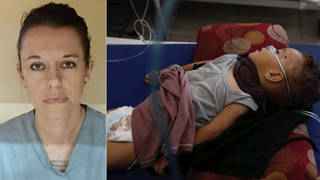
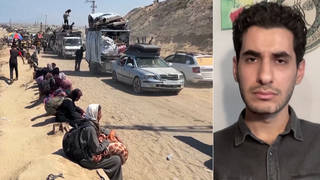
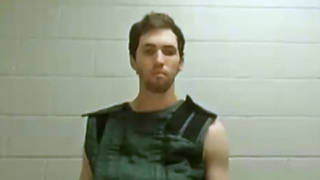
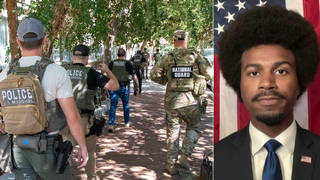
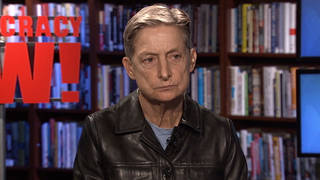
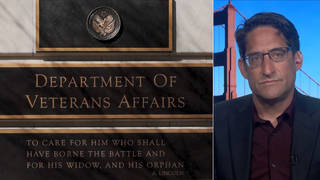
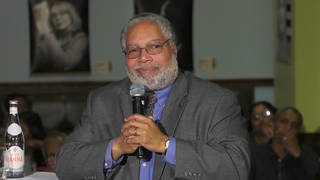
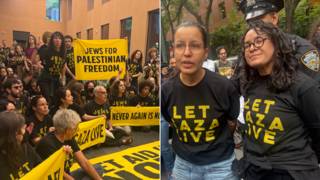

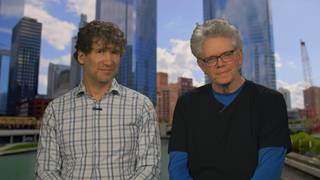

Media Options